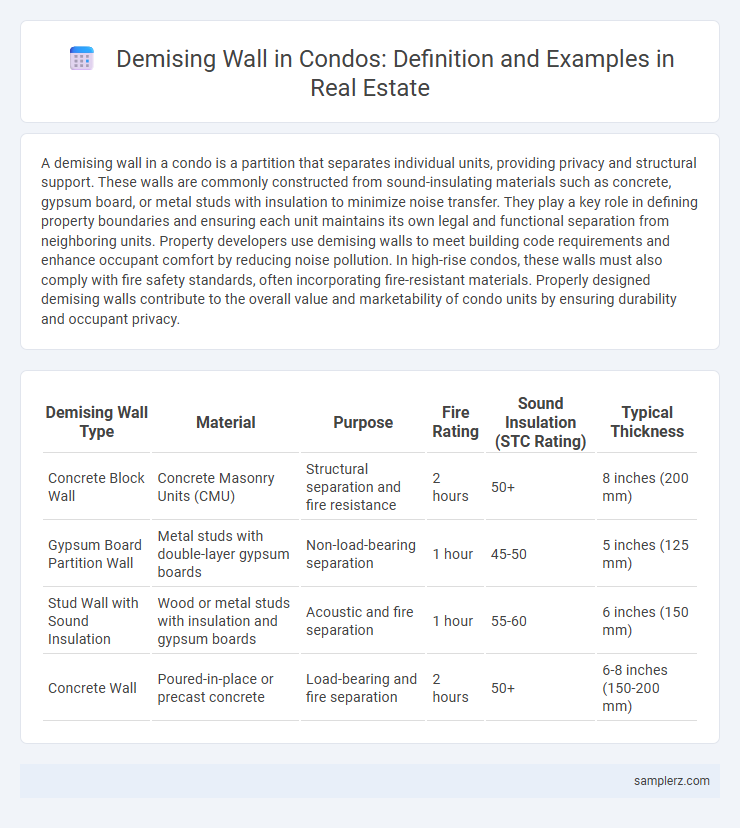A demising wall in a condo is a partition that separates individual units, providing privacy and structural support. These walls are commonly constructed from sound-insulating materials such as concrete, gypsum board, or metal studs with insulation to minimize noise transfer. They play a key role in defining property boundaries and ensuring each unit maintains its own legal and functional separation from neighboring units. Property developers use demising walls to meet building code requirements and enhance occupant comfort by reducing noise pollution. In high-rise condos, these walls must also comply with fire safety standards, often incorporating fire-resistant materials. Properly designed demising walls contribute to the overall value and marketability of condo units by ensuring durability and occupant privacy.
Table of Comparison
| Demising Wall Type | Material | Purpose | Fire Rating | Sound Insulation (STC Rating) | Typical Thickness |
|---|---|---|---|---|---|
| Concrete Block Wall | Concrete Masonry Units (CMU) | Structural separation and fire resistance | 2 hours | 50+ | 8 inches (200 mm) |
| Gypsum Board Partition Wall | Metal studs with double-layer gypsum boards | Non-load-bearing separation | 1 hour | 45-50 | 5 inches (125 mm) |
| Stud Wall with Sound Insulation | Wood or metal studs with insulation and gypsum boards | Acoustic and fire separation | 1 hour | 55-60 | 6 inches (150 mm) |
| Concrete Wall | Poured-in-place or precast concrete | Load-bearing and fire separation | 2 hours | 50+ | 6-8 inches (150-200 mm) |
Understanding Demising Walls in Condos
Demising walls in condos are structural partitions separating individual units to ensure privacy and sound insulation. These walls often incorporate fire-resistant materials and soundproofing solutions to meet building codes and enhance resident comfort. Proper understanding of demising walls helps homeowners and developers maintain property value and comply with safety regulations.
Common Materials Used for Condo Demising Walls
Condo demising walls typically use materials such as concrete, gypsum board, and metal studs to ensure soundproofing and fire resistance. Concrete offers robust structural support, while gypsum board combined with insulation enhances acoustic separation between units. Metal studs provide a durable framework, enabling flexibility during design and installation in multi-family residential buildings.
Legal Definitions of Demising Walls in Real Estate
Demising walls in condominiums refer to the legally defined partitions that separate individual units, establishing clear boundaries for ownership and liability. These walls are subject to specific building codes and condominium bylaws that dictate their construction, soundproofing, and fire resistance requirements. Understanding the legal definitions ensures compliance with property regulations and protects the rights of unit owners in multi-family real estate developments.
How Demising Walls Affect Condo Privacy
Demising walls in condos serve as critical barriers between units, directly influencing the level of privacy residents experience by minimizing noise transmission and visual intrusion. Constructed with soundproofing materials such as gypsum board, insulation, and resilient channels, these walls significantly reduce everyday disturbances, enhancing the comfort of living spaces. The quality and thickness of demising walls play a crucial role in maintaining privacy, affecting property value and resident satisfaction within a condominium community.
Example Layouts Featuring Demising Walls in Condos
Example layouts featuring demising walls in condos often include configurations where shared walls separate individual units, enhancing privacy and sound insulation. Common designs integrate demising walls between living rooms and bedrooms or kitchens and adjacent units, maximizing efficient use of space while adhering to building codes. These layouts ensure clear boundaries for heating, cooling, and utilities, contributing to resident comfort and property value.
Ownership Responsibilities for Demising Walls in Condos
Demising walls in condos serve as the partition between individual units and are typically jointly owned by the adjoining unit owners, making maintenance a shared responsibility. Condo bylaws or association agreements usually specify that repair and upkeep costs for demising walls are split proportionally based on ownership interests or usage. Understanding these ownership responsibilities is crucial for avoiding disputes and ensuring proper maintenance of shared structural elements.
Demising Walls vs. Partition Walls: Key Differences
Demising walls in condos serve as structural barriers that separate individual units, providing soundproofing and fire resistance mandated by building codes. Partition walls, in contrast, are non-load-bearing and designed primarily for interior space divisions within a single unit, often lacking stringent fire and acoustic requirements. Understanding these differences is crucial for compliance with regulations and ensuring privacy and safety between condo units.
Soundproofing Standards for Condo Demising Walls
Condo demising walls must meet stringent soundproofing standards, typically requiring a Sound Transmission Class (STC) rating of 50 or higher to minimize noise transfer between units. These walls often incorporate multiple layers of drywall, resilient channels, and sound insulation materials such as mineral wool or fiberglass to achieve superior acoustic performance. Compliance with local building codes and industry guidelines ensures privacy and enhances resident comfort in multi-unit residential buildings.
Fire Safety Requirements for Condo Demising Walls
Condo demising walls must comply with stringent fire safety requirements, ensuring a minimum fire-resistance rating of at least one hour to prevent the spread of fire between units. These walls typically include fire-rated gypsum board assemblies, fire-resistant insulation, and sealed penetrations to maintain the integrity of the barrier. Meeting local building codes and fire regulations is essential to enhance occupant safety and protect property value in multi-unit residential buildings.
Resolving Disputes Involving Condo Demising Walls
Demising walls in condos, which separate individual units, often become focal points in disputes over soundproofing, property boundaries, and remodeling permissions. Effective resolution involves thorough review of condominium bylaws, expert assessments of wall structures, and mediation between unit owners to ensure compliance with local building codes and minimize disturbances. Clear documentation and proactive communication prevent conflicts and uphold property values in multi-unit residential buildings.

example of demising wall in condo Infographic
 samplerz.com
samplerz.com